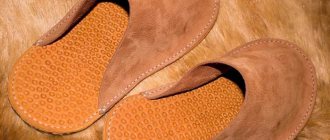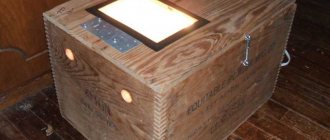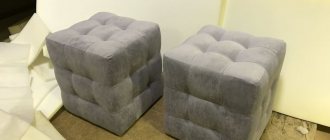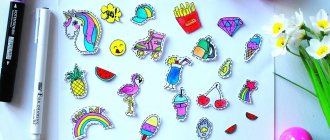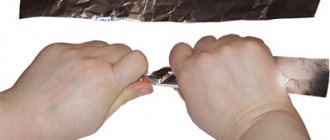What to do with dull knives?
If there are no problems with knives with replaceable blades (naturally, if these same blades are present), then a knife with a sharpened blade must be periodically sharpened. Typically, a special knife sharpening device is used for this.
Buying this now is not difficult. But not everyone prefers this solution to the problem. And the point here is not only the considerable cost of such devices. High-quality sharpeners cost a lot of money.
Many craftsmen will get great pleasure from a machine designed for sharpening knives, made by themselves. Although, even using an ordinary “bare” block, of course, you can sharpen knives with your own hands, but in order to sharpen a knife efficiently using only a whetstone, also known as a “block”, you need to have a certain skill and “steady” hands, because you will need to maintain the sharpening angle identical along the entire cutting edge, and this is not the easiest task. A special sharpener for knives is designed to make it easier, be it factory-made or made with your own hands.
But just to speed up sharpening, any sharpener, both factory-made and home-made, will help.
Basic information on sharpening knives
Whether it’s an elite purchased artificial stone for sharpening, or a cheap cobblestone from Soviet times, the rules for sharpening knives apply equally to both the former and the latter.
Specialized sharpeners can reduce the effort involved in the process without a significant drop in quality, but the less influence a person has on sharpening, the more expensive the purchase will cost him in monetary terms.
1) Angle + rules for uniform sharpening
The sharpening angle is selected for each blade individually, depending on its area of application. For 96% of knives, general recommendations were derived, but there are 4% of blades that require a person to have a zonal distribution, that is, in different parts of the blade, it is necessary to maintain different values of inclination.
Folk devices for sharpening drills versus ready-made ones
| Sharpening angle | Blade type |
| from 9 to 16 | Blades for surgical purposes. This also includes straight razors used by barbers. |
| from 16 to 26 | Specialized knives used by pastry chefs and other culinary specialties. For example, knives for bread, vegetables or meat. |
| from 19 to 26 | Ordinary knives that are used for household purposes. |
| from 24 to 31 | Specialized knives for hunting, fishing and hiking. |
| from 32 to 45 | More rigid blades, most of which are not knives at all - axes, cutlasses, machetes, carpentry tools, etc. |
It makes no sense to indicate the exact value of the sharpening angle, because if a person sharpens the blade using the same water stone, then maintaining the same value of inclination in relation to the block will be unrealistic from a physical point of view. This gives rise to the range of permissible vibrations when working with the tip.
Recommendations for sharpening a knife by hand:
- high-quality fixation of the blade allows you to avoid slippages that harm the edge of the tip. In addition, a careless attitude towards this issue can lead to injuries to those sharpening;
- the whetstone must move along the edge of the blade at a uniform speed, without delays or stupors in the middle;
- the point of contact of the tip with the sharpening element should be located at a perpendicular angle;
- the applied pressure on the plane of the blade must be commensurate with the area of the tip touching the sharpener.
And of course, don’t forget about maintaining the sharpening angle. Only comprehensive implementation of all the above recommendations will allow you to achieve high quality sharpening of the blade of even the dullest knife that you can find in your own household.
2) Classification of sharpening tools
If we are talking about the classic idea of sharpening a knife blade, then here the abrasive plays the first role. There are many sharpening stones and most of them are quite inexpensive. Another question is the sharpener's skills. In their absence, it is more rational to turn to more automated devices, which we will discuss in the second part.
| Type of whetstone | Peculiarities |
| Water | Before use, such a block is soaked for 15-30 minutes in water. Thanks to the preparatory stage, you can save up to 40% of the sharpening surface of the stone, which makes the material suitable for purchase by thrifty owners. |
| Oily | Its structure is similar to water, but has a more oily surface, which allows you to avoid soaking it before use. A less economical option for a sharpener. |
| Natural | The basis is natural stone with industrial post-processing. Expensive pleasure. |
| Artificial | The abrasive is based on non-natural elements. Cheap analogue of natural. |
| Rubber | Not a very convenient option for sharpening a kitchen knife, but there are some on sale. |
The advantages of using sharpening stones include versatility, long service life (for generations) and compactness of the item. Among the disadvantages, we highlight the need for manual sharpening skills and the occurrence of unevenness on the stone, which leads to uneven sharpening of the blade.
VIEW Professional sharpening stone on AliExpress →
Please note: some craftsmen make sharpening bars with their own hands. It is based on 3-5 layers of glass 0.5 centimeters thick. The layers are joined together with glue, and sandpaper of the desired grain size is put on top. If necessary, a person can replace a worn component with a new one at any time. Comfortable.
Other hand sharpening products also include musat - a rod with a certain level of roughness for adjusting and sharpening knives at the final stage.
VIEW Musat – rod on AliExpress →
The classification of musats is made based on the geometry and materials used in the manufacture of the sharpening element. The basic indicator for musat is the roughness of the drawing, which is the size of the notches on the surface of the rod.
For more advanced users there are alternatives:
- manual sharpening machines.
VIEW Manual sharpening machines on AliExpress →
It’s quite easy to make such a sharpener with your own hands. It’s easy to find drawings with instructions on the Internet. If you are too lazy to engage in amateur activities + don’t mind a couple of thousand rubles - specialized stores are waiting for you;
- electric sharpeners.
VIEW Electric knife sharpeners on AliExpress →
Not every housewife would want to see such a bandura with a motor in her own kitchen. Qualitatively? Yes. Comfortable? Not always. The artificial abrasives of such machines are not always of high quality, so the choice should be taken with great responsibility.
In addition to large assemblies, compact variations of such equipment can often be found in markets and Chinese online stores. Small manual and electric sharpeners adequately perform their functions, but housewives simply kill their knives with such sharpening. In 60% of devices, the emphasis is not on rough cutting of metal, but this is a direct path for your elite knife to the trash after 3-7 sharpenings.
3) Instructions for manual sharpening
Before you begin, you should learn 3 rules - maintaining the angle, applying even and gentle pressure on the surface of the blade, and pre-rinsing the sharpening stones before direct use.
Let's take a closer look at the algorithm of actions for a beginner. Instructions for sharpening knives:
- We wash the block from metal shavings, dust and crumbs of the stone itself, which will be used further.
- We are preparing a place for work. The most important point is to conveniently position the stone. The speed and quality of sharpening the blade will depend on this.
- Let's decide on the sharpening angle depending on the selected type of tool. The higher the quality of the steel, the finer the blade sharpening is required. For a cheap knife from the kitchen, this parameter is not as important as for sharp razors and fillet knives.
- We sharpen it away from ourselves. When moving from a straight line of the blade to a curve, we gradually change the angle (figure below), maintaining perpendicularity between the direction of movement and the point of contact of the edge with the block.
- Periodically wash the stone and shake off metal shavings.
- We continue sharpening at an angle until a small burr forms on the edge. Turn the knife over and repeat the procedure for the second side of the blade.
- Having achieved the result with a medium-grained abrasive, we change the stone to a finer one, and repeat sharpening according to the same principle, but with a fewer number of repetitions (50%-70% less). Changing the block for kitchen and grocery specialized knives for the third time does not make much sense.
- To achieve razor sharpness, we grind the edge of the blade with leather using GOI paste.
To make it easier to change and maintain the sharpening angle, it is better to use special devices. For example, a homemade knife sharpener. Drawings with dimensions are easy to find in the public domain on the world wide web, and in terms of cost, this equipment option will cost 3-5 times less than a purchased mechanism analogue.
Possible errors when sharpening manually:
- Using a single sharpening stone. To get a full-fledged blade with high sharpness, you need at least 2 bars with different levels of grain.
- The formation of false burrs can confuse the sharpening edge. The blade will become dull after a couple of weeks, and the edge will have to be sharpened again.
- Sharpening occurs without first cleaning the blade from dust and grease. The cleaner the blade, the better a person can sharpen the knife.
- Strong blade pressure. In this way you will spoil not only the surface of the stone (its evenness), but also kill the very edge of the knife.
And of course, if you do not maintain the required sharpening angle for the blade, the work will go to waste. This is especially true for specialized knives made of high-quality steel, which are not cheap.
What are the differences between abrasive stones?
Sharpening stones come in a variety of shapes, bar sizes, and grain sizes. The optimal size of the bar is considered to be one in which its length exceeds the length of the blade of the knife being sharpened by at least one and a half times. This allows you to work with such a bar much more comfortably than with a bar that does not meet this simple requirement.
As mentioned earlier, sharpening stones can have not only different sizes, but also very different grain sizes. There are five main levels of grain size for such bars:
- Grain size 200-300 Extra coarse. In English called Extra coarse. Such bars are not used for sharpening tool blades and knives in particular;
- Grain size 300-350 Coarse grain. In English called Coarse. With the help of such bars, damaged or very dull blades are sharpened;
- Grain size 400-500 Medium grain. In English called Medium. You can do without such a block in the household;
- Grain size 600-700 Fine grain. Called Fine in English, these whetstones are the most popular for sharpening tool blades in the home workshop.
- Grain size 1000-1200 Very fine. In English called Ultra fine. These bars are used for final processing of blades that need to be brought to a shine. Such bars can be used as a tool for a homemade knife sharpener.
Making a sharpener step by step
Step one: It is necessary to correctly measure and cut the metal corners. You can complete this step with a grinder and then clean it with a file and sandpaper.
Step two: You need to drill small holes in the fastening areas and process the edges of the guide rail.
Step Three: The bolt and nut will serve as the stand. The improvised stand must be secured between a vice or on any other convenient unit.
Step Four: Now it’s time to assemble the sharpener. Next, you need to attach a sample for the first sharpening test and the sharpening stone itself.
Step five: Test the device.
It should be noted that many of the parameters here are individual and the dimensions of the sharpener are often set by the manufacturer himself.
Why do knives get dull?
In order to ensure long and comfortable work with a knife after sharpening, first of all try to answer the question, “Why do knives become dull?” Why is it necessary to sharpen the knife again some time after sharpening, and sometimes to completely sharpen the knife again?
The reason for the loss of sharpness by the cutting edge of any tool is this: when working, the cutting edge of a knife or any other tool is exposed to the smallest abrasive particles of the material being cut.
Such particles are found in any material, be it stone, wood, or food.
Even soft vegetables and fruits contain such particles. There may just be more or less of them, but they will definitely be there. Their size, sharpness and quantity only determine the speed at which the instrument will become dull.
Fixation device
The second important part of the tool rest is the clamping bar. It can be made from 2 parts.
L-shaped plank measuring 150x180 mm, the width of the shelves is 50 mm (top);
A rectangle-shaped strike plate measuring 50x100 mm (bottom).
When making a clamping bar, the machine operator performs the following actions:
Places the bottom bar on the far edge of the top bar;
Makes 2 holes in the center and retreats 25 mm from the edges of the part, connects the parts through the holes with two 8 mm bolts;
Screws in 8 mm bolts on 2 sides. In such a situation, the head of the nearest bolt is located near the top bar;
Welds the bolt heads to the plates and grinds them in advance until roundness is formed;
Yes, the inclined board retreats 40 mm from the edge and draws a line with a thicknesser;
Makes one 8 mm 25 mm gap at the bottom and top edges;
Using markings, he connects the edges of the slots and uses a jigsaw to make a cut with an allowance. Use a file to expand the groove to a width of 8.5 mm;
It fastens the planks using a groove that is in the board; the top bolt is tightened with a nut and thus firmly fastens the plank.
Then tightens connection 2 with nut;
When pressing the bottom bar (in the niche of the base), screw a wing nut onto the second bolt.
Sharpening angle, what is it?
So, since it is impossible to stop the process of dulling the cutting edge, then at least try to slow it down, and for this you need to sharpen your tool very well. Earlier in this article you have already come across such a concept as the sharpening angle of the cutting edge. And now more about it.
Blade sharpening angles can vary greatly. From an angle of about 10 degrees for razors and scalpels, to an angle of about 50 degrees for various Machete-type knives.
Making a homemade machine
It is quite possible to make a knife sharpening machine yourself at home. The main requirement when creating a homemade sharpening machine is to rigidly secure the blade being sharpened and the abrasive element. Thanks to this, the main requirement for the entire procedure is achieved: creating and maintaining a sharpening angle.
Elementary vertical device
The device is designed for quick manual sharpening of knives with your own hands and is a wooden structure assembled in the form of a corner. The exact assembly drawing will not be given here, since the dimensions depend on the size of the grindstone used. You need to prepare:
- 4 bars or planks 5-7 cm wide and 2-3 cm thick. The length of the plank is determined by the length of the stone;
- 4 M4-M6 bolts with a wing nut. The length of the bolts is determined by the formula: (thickness of the board) x 2 + thickness of the whetstone + 1 cm;
- 4 self-tapping screws for wood. The length is selected based on the following calculation: board thickness minus 0.2 cm;
- Protractor or other angle measuring tool;
- A drill with a drill, the size of which is equal to the size of the bolt, or larger by one unit of the size range;
- Wood hacksaw;
- Chisel or chisel (or a powerful knife);
- Pencil or marker.
Making the device involves assembling two corners from existing planks. On one of them, at a distance equal to its width, a cut is made with a hacksaw to the middle. Then, from the end of the board, the sawn-off part is chopped off with a strong knife or chisel. A similar chip is made on the second plank. This is done so that when connecting the boards into a corner, both sides have a common plane. Then the boards, with their chipped parts, are joined into a corner. The second half of the device is assembled in the same way. Next, holes for connecting bolts are drilled in the upper and lower parts of the device. The holes are marked at the ends opposite to the junction, 3-4 pcs. on every board. The holes are marked so that there is at least 3 cm from the edge of the board to the outer bolt, and the distance between it and the other holes allows the edge of the sharpening stone to be securely clamped.
A mark corresponding to each of the future sharpening angles is applied on the inside or outside of one of the boards.
Sharpening work is carried out in the following algorithm: the knife to be sharpened is placed with the blade on the sharpening stone so that it is in a vertical plane. Then you need to move the knife along the sandpaper in a back-and-forth motion, with light pressure. Finer sharpening or grinding of the blade on this machine can be done if the sharpening stone, before installing it in place, is wrapped in sandpaper of the desired grain size.
The advantage of such a device is its simplicity, ease of assembly and low cost. The disadvantage is the lack of rigid fastening of the sharpened blade.
Sharpener from mounting angles
The proposed device is more advanced compared to the previous one. The blade to be sharpened is rigidly fixed in it and the angle of inclination of the emery in relation to the blade is fixed. Another difference is that in this device the moving part is a stone rather than a blade.
The device is attached directly to the knife blade, in its upper part. The device consists of two interconnected metal corners and a movable part resting on one of the shelves.
The following figure is schematically indicated:
- The basis of the design is 2 corners.
- A movable rod or knitting needle with a thread.
- Clamping nuts with washers for securing the emery to the rod.
- Lever.
- Holes for adjusting the sharpening angle and supporting the moving part.
- Set of adjusting washers.
- Tightening bolts with nuts.
- Stitched edge of the top corner.
- A sharpened blade or knife.
- Whetstone (whetstone).
Manufacturing the device begins with selecting the corners of the base. In the vertical shelf of the upper corner, 3-4 holes are drilled with a size larger than the size of the rod by 3 steps. For example, for a rod with a diameter of 6 mm, 9 mm holes are required. The outer edge of the upper plane of the upper corner is ground down “to the bottom” at a distance of 10-12 cm from the end, so that the emery does not touch it when sharpening. In the horizontal shelves of both corners, two holes are drilled coaxially for the coupling bolts. These holes are drilled according to the principle: the first - at the end of the grinded part of the upper corner, the second - 10-12 cm from the first. The thickness of the set of shims should be equal to the thickness of the blade being processed. The diameter of the clamping washers located on the movable rod should be equal to the thickness of the sharpening stone multiplied by 2. As a handle, you can use a piece of PVC pipe of a suitable diameter or wrap several layers of electrical tape. To prevent the moving part from jumping off the blade, the rod on the outside of the upper shelf must be bent in the shape of the letter “L”, or secured with a locked nut if there is a thread.
What could cause such a significant difference?
The fact is that the sharpening angle depends on what materials the blade is supposed to cut. The smaller the angle, the softer the materials should be and vice versa.
The fact is that a blade with a small sharpening angle will not only be easier to cut, but will also become dull more easily. That is why there is not and cannot be a single universal sharpening angle.
Note!
- Do-it-yourself compressor: selection of materials and tools for assembly at home + step-by-step instructions for making and assembling yourself
- Homemade products for the garage with your own hands: options for products for arranging a garage, detailed diagrams and drawings for creating with your own hands
- Do-it-yourself press - design features, choice of manufacturing materials. Step-by-step instructions for making it yourself + simple diagrams and drawings
After reading this article, you will not only learn how to properly sharpen a knife so that it can serve you for a long time until the next sharpening, but also answer your question about how to make such sharpening easier.
To facilitate the correct sharpening of knives, a lot of different tools have been invented, from the simplest devices to the most exotic ones, at a quick glance at which it is not only unclear how to work with them, but it is also difficult to figure out what it is in general.
How to make a budget knife sharpener
Necessary materials:
- plywood or MDF;
- wooden block;
- round pipe (steel or aluminum);
- nuts;
- threaded rod;
- profile pipe.
The peculiarity of this design is that there is no need to make a base for it - all structural elements can be fixed directly on the work table while sharpening the knife.
The first step is to make a guide sleeve for the handle with the form.
We cut out a round piece of the required size from a piece of plywood or MDF, and then drill a hole in the center. We press a piece of round pipe into the resulting ring.
A round pipe will be inserted into the guide sleeve. You can take a steel one, but in order not to make the structure heavier, it is better to use an aluminum tube.
Next, we need a wheel with a mount from a cabinet or chair.
The wheel itself (in this case it has the shape of a ball) is removed. Instead, we attach a guide sleeve using 2 self-tapping screws.
We weld a nut to the end of the round pipe. If you are using an aluminum tube, it can be rounded and pressed inside. Or you can solder the nut using special solder.
We screw a piece of threaded rod into the welded nut.
We screw the mount with the bushing to the end of a wooden block, which is mounted on the desktop in a vertical position. We insert the handle into the guide.
We cut two identical pieces from a rectangular profile pipe and drill holes in them.
We put the blanks on the threaded rod and secure them with nuts. Between the clamps we install a form for sharpening the knife.
The knife or hatchet itself is attached to the edge of the work table using screws.
You can watch step-by-step instructions on how to make a simple knife sharpener with your own hands below in the author’s video. This idea was shared by the author of the YouTube channel Be Creative.
How to make a Knife Sharpener | Be Creative
If there is no space on the workbench, then you will need to make a base. You can use a piece of plywood or furniture board for this.
Advice from the master: it is better to start sharpening the cutting edge from the base of the knife, smoothly moving towards the tip.
What knives can be sharpened?
Not all blades can be sharpened at home, but only blades made from not very hard materials. So, if the hardness of the material from which the blade is made exceeds 55 units on the Rockwell scale (55HRC), then it will not be possible to sharpen it with any tool available to most people. But most of the knives produced now are made of fairly soft materials and such knives are not at all difficult to sharpen.
True, their service life between sharpenings is not long at all.
But no matter what metal the knife is made of, sooner or later it will still have to be sharpened. The only exceptions to this rule are knives with replaceable blades and ceramic knives that cannot be sharpened at all. Thus, a knife sharpening device must be universal, that is, it must be able to sharpen various blades with different sharpening angles.
Note!
- Do-it-yourself winch: classification, manufacturing materials, description of work stages + instructions for DIY construction
- Do-it-yourself clamp - step-by-step production and description of options for using a clamp
- DIY knife | A step-by-step description of how and from what materials to make a homemade knife
Therefore, when creating a device for sharpening knives, it is necessary to provide for the possibility of sharpening blades with different angles, and this is the most difficult task both at the design stage and during the manufacture of such a device.
Preparing to form a knife sharpener
What is required to carry out the procedure? Materials and tools, which should include the following items:
- Stone for sharpening knives;
- Grinder with diamond blade;
- Wooden boards (1 large is possible);
- Grinder/sandpaper;
- Pen/felt-tip pen and ruler;
- Small nails and hammer;
- Varnish and brush.
What properties should a sharpener have?
So, before you make a device for sharpening knives with your own hands, you need to think about its design. And to do this, you need to answer the question: what properties should a knife sharpener have:
First, any device for sharpening knives must securely fix the knife, preventing it from falling out, but without damaging the blade material.
Secondly, a homemade knife sharpener must ensure that the block is held at a strictly defined angle, which is necessary for sharpening the entire cutting edge at a constant angle.
Third, the most difficult and perhaps the most important, a sharpening machine for knives, both self-made and factory-made, should allow changing the angle of installation of the sharpening stone; this is necessary to ensure sharpening of various tools and will even allow sharpening of stepped knives.
Note!
- DIY vices: simple and reliable homemade vices from A to Z (190 photos)
- Do-it-yourself vibrating table - selection of materials, components and assemblies for a vibrating table with a step-by-step manufacturing description
- Do-it-yourself grain crusher - operating principle, types and features of creating a device for processing grain crops
Device for sharpening from mounting angles
The diagram and drawings of a homemade knife sharpener made from mounting angles, based on a Lansky device, are clearly shown below.
Diagram of a homemade sharpener made from mounting corners
To assemble this device you will need:
- Metal corners 90*90 mm with a wall thickness of 6 mm.
- Stud with M6 thread and length 160 mm.
- Thin rod (electrode, knitting needle, etc.).
- Touchstone.
- 2 rectangular pieces of metal (sponges for clamping the whetstone).
- Pliers.
- Hacksaw for metal.
- File (or any other tool for processing sharp corners).
- Set of hardware (nuts and bolts).
Drawing of clamping jaws of a Lansky type device Drawing of clamping jaws of a Lansky type device
Holes should be made in the metal corners and threads cut into them according to the drawings. Then grind off the bevels on the jaws that secure the knife blade in order to prevent interference with the movement of the whetstone. All sharp corners and edges of the future sharpening device must be processed with a file.
Diagram of a finished sharpening device made from mounting angles
In both metal jaws intended for fixing the keystone, you need to drill holes and cut a thread for the connecting bolt. Fix the touchstone. A thin smooth knitting needle, previously bent at an angle of 90º, must be inserted and secured in the hole of one of the jaws. In the future, using this knitting needle-shaped clamp, a certain angle of inclination of the touchstone will be set. Such a device for sharpening knives is characterized by a wide range of sharpening angles, which will undoubtedly be of interest to most craftsmen.
What will we make it from?
The next question to consider is.
The materials from which you will make it.
To create such a device you will need the following materials:
- A sheet of thick plywood (can be replaced with a sheet of chipboard) 16 mm thick;
- Self-tapping screws 50-70 mm long; (it is better to use furniture format);
- A drill corresponding in diameter and length to your self-tapping screws or conformation;
- M8 hairpin of appropriate length (approximately 70 cm);
- Aluminum plate (at least 5 mm thick);
- M8 bolts with nuts (it is advisable to use wing nuts, although you can also use regular nuts, but keep in mind that then, with each sharpening, you will have to use a wrench, and this, you will agree, is not very convenient);
- You will also need a small block of textolite or ebonite to create a movable connection between the stud and the frame, which can be adjusted in height (if necessary, it can be replaced with a block made of hard wood, for example, it could be oak, beech or hornbeam);
- Of course, you will also need abrasive stones of various grain sizes;
- You will also need a powerful neodymium magnet (“you can get” such a magnet from an old computer hard drive that has become unnecessary).
Using replaceable blocks and making a carriage
When making a sharpening carriage, the machine operator performs the following actions:
Welds 30 cm M10 threaded rods with a smooth rod whose thickness is 10 mm;
Uses 2 solid bars 50x80 mm and the thickness is 20 mm. In all blocks, in the center and on top, 20 mm is retreated from the edge, and then a gap is made 10 mm wide;
Screws a wing nut onto the rod, then a large washer and 2 bars, then a nut and washer;
Clamps rectangular sharpening stones between the stones or makes several replaceable sharpening stones.
As a timber base, the machine operator uses a rectangular tube from a profile or a piece of cornice, the width of which is 50 mm;
He sands the flat machine part and cleans it of grease, and glues strips of sandpaper with a grain size of up to 1200 grit using Super Moment glue.
The sandpaper should have a fabric base, and on one of the blocks you need to glue a strip of suede to apply polish to the blades.
What are we going to do?
The tools you will need are: a drill, a drill of a suitable length and diameter, a screwdriver with bits suitable for your screws or format. Instead of a screwdriver with suitable bits, you can also use a screwdriver (but this will be more difficult).
Any tool for cutting metal (a hacksaw or an angle grinder equipped with a cutting wheel).
Sharpener cover
You can create a lid to cover the stone. You just need to measure the protruding part of the stone. The depth of the lid (the height of the walls) should be 1-2 mm less than the protrusion of the stone from the box.
With this approach, it will actually be possible to cover the sharpening stone with a lid without disturbing the sealing area. This is an important point to consider when doing important work.
- The lid is nailed together using thin nails. You can use plywood. It needs to be polished.
- Usually done with fine-grained sandpaper. The lid needs to be well treated to avoid splinters.
It's better to coat it with varnish. There is no need to feel sorry for it, but it is important to distribute it evenly. You can use 2 brushes for this.
One of them is soft for basic application, and the other should have hard hairs in order to go through difficult areas with its help. Everything should work out, because the work is simple. Just make sure that the varnish is evenly distributed.
How will we do it?
Having asked the question “how to make a knife sharpener?” First of all, let’s find drawings for our future knife sharpener, which we will make with our own hands, and to do this, enter the following query into the search bar: “device for sharpening knives drawings.”
In response to such a request, any search engine will return a large number of suitable search results. Choose the one you like.
Having cut the plywood in any convenient way into parts for our future frame, we drill them at the points of attachment to each other, and then fasten them with self-tapping screws or conformat to each other.
On the frame we fix, using a bolt, an aluminum plate pre-processed according to the drawing (it will serve as a clamp for the knife being sharpened).
Next, we attach a vertical section of the pin to the frame and firmly fix a “cracker” on it. It consists of two parts made of an ebonite block (the Cracker is a very important part, it determines the angle at which the abrasive bar and the blade being sharpened will come into contact).
Now let's create a mount for the abrasive stone: for it we use the remaining section of the pin. Two blocks of ebonite or other similar material and two nuts.
Sharpener with rotary mechanism
If the previous two options for homemade tabletop sharpeners do not suit you for some reason, and you need something more practical and functional, we bring to your attention a sharpening device with a rotating mechanism.
The idea of this homemade product was shared by the author of the YouTube channel “Hands from Shoulders”.
Necessary materials:
- plastic pipe clips;
- tablet;
- fastening - screw with nut;
- polypropylene pipe;
- bolt 12 mm;
- professional pipe;
- T-shaped aluminum profile;
- clamps;
- metal plates.
The first step is to connect the two clips together using a screw and nut. In this case, plastic clips are used for a PP pipe with a diameter of 25 mm and an M4 screw.
To prevent the fasteners from touching the pipe, a small countersink must be made on the inside of each clip - for example, using a countersink or drill of a suitable diameter.
At the next stage, we cut two pieces from a piece of polypropylene pipe with a diameter of 25 mm - insert them into the clip, and then fix them.
Now let's start making the homemade base. We saw off a piece of plywood or a board 120 mm wide (length is at your discretion).
We make markings and drill a hole at an angle of about 70 degrees. Cut a piece of PVC pipe with a diameter of 16 mm and insert it into the hole.
For greater reliability, you can additionally secure the pipe with a self-tapping screw or “plant” it with glue.
Next, cut two rings from a piece of polypropylene pipe. We drill holes in them and screw in the screws. These parts will serve as stops for a guide made from clips and pieces of pipe.
To make a rotating mechanism you will need: a bolt with a diameter of 12 mm, an aluminum brand, a polypropylene pipe with a diameter of 20 mm and a corrugated pipe 20x20 mm.
It is necessary to drill a hole in the center in the profile pipe. We also drill two more holes along the edges, and use rivets to attach the aluminum brand to the corrugated pipe.
For the knife holder, two pairs of metal plates measuring 40x80 mm are used. If the knife blade is short, then one pair is enough. We fasten the plates to the T-shaped profile using a screw and nut.
We insert a nut inside the profile pipe, and then screw in an M12 bolt, onto which we first need to put a piece of PP pipe with a diameter of 20 mm. Fix the bolt with a nut on the other side.
We put two metal clamps on the polypropylene pipe and screw them to the base.
The rod for forms can be made from 16 mm PVC pipe. If possible, it is better to use an aluminum pipe. We put two pieces of polypropylene pipe with a diameter of 25 mm on the rod.
To make the connection more dense, you can use heat shrink.
Forms can be made from ordinary glass or plexiglass with a thickness of 4-5 mm. And as an abrasive material, waterproof sandpaper is used, which is attached to double-sided tape.
For form holders, plastic clips are used for PP pipes with a diameter of 25 mm.
We assemble all the design details together, after which we can begin sharpening the knives.
The step-by-step process of making a tabletop machine for sharpening knives with your own hands is shown in the video below.
Razor sharp tool using plastic pipes!
Thanks to the presence of a rotating mechanism, there is no need to unfasten the knife each time to sharpen the opposite side of the cutting edge.
What did we get?
Having assembled the design according to the drawing, you will receive the simplest device for sharpening knives, however, despite its simplicity, this device will allow you to sharpen knives and any other blades quite efficiently.
In order to understand how to use such a device, just enter “video knife” in any search engine.
Did you manage to sharpen the knife? Hooray! You have successfully made a DIY sharpening machine.
We should not forget that any sharpening machine, even if it is made by hand, requires strict adherence to the rules and safety requirements!!!
Working with stone
To begin with, it is worth performing some manipulations regarding the stone. It is a working surface.
What is required from a person?
- Marking the working surface. It is better to use a rectangular shape: it is convenient to sharpen knives and it is easy to make a box.
- The stone is given its shape using a grinder. You also need to use a vice in which the object will be fixed.
- If possible, it is worth sharpening the stone using a diamond edge on an angle grinder.
This is where the procedures end. Next, you need to complete the rest of the work, which is described below.
Further actions:
- It is important to create a box in which the stone will be placed. To do this, they measure the stone and mark out the boards to cut out the pieces. An important point must be taken into account: the box must be such that the stone fits tightly into it and does not fall out when it is turned over.
- You can use glue that is poured into the box. This will allow you to secure the stone more firmly. This is an important point to consider, but it is not necessary if the box fits tightly around the stone. But it’s unlikely that anyone will pull it out, so the use of glue is worth considering.
- We need to make a box. To do this, mark the board/boards so that the sidewalls wrap around the stone. Here you need to take into account an important point: the working surface should protrude above the box by 3-5 mm. This will prevent damage to the box.
- Parts of the box need to be sanded. You will need sandpaper. You can choose fine grain options. This type of sandpaper will solve problems associated with sanding. A grinder will also work if it has an abrasive side installed. It all depends on what tools a person has at his disposal.
- Using a brush, distribute the varnish over all surfaces of the boards, which are then dried. This is important in order to preserve parts of the box. They should not be damaged. The varnish will protect them from mechanical and, partly, chemical damage.
- The parts are hammered together so that the nails do not protrude to the surface. It is important to act carefully so as not to damage the elements. This is due to the fact that the thickness of the boards is usually 0.4-0.7 mm. Large numbers will be heavy. The silence parameters indicated above will suffice.
Photo of a DIY knife sharpener
Sharpening accessories
A standard chisel sharpening kit includes three main components: an abrasive for initial processing, abrasives for finishing, and a sharpening mandrel for fixing the angle at which the blade needs to be sharpened. The latter is divided into two types: equipment, with which the cutting edge can be sharpened on an abrasive wheel of an electric sharpener, and manual mandrels for grinding on bars and sheet abrasives. Manual devices have many options: from homemade wooden devices, in which the angle is set with wedges, to factory-made metal products with angle adjustment. All of them are designed approximately the same and consist of two main functional components: a carriage for moving along the abrasive surface and an inclined platform with a clamp, which is set at the required angle before sharpening the blade. In order to sharpen a chamfer, both hand tools and power tools are used, but the finishing of the cutting edge is done only by hand.
Making a sharpening device
The device shown in the figure is suitable for chisels and plane blades with a length of at least 75 mm with a sharpening angle of 25°. You can make several of these to sharpen at other angles.
Elements that make up the sharpening device
First, cut out the base (A) from hardwood, such as maple, with an allowance for length. The workpiece should have dimensions of about 13x76x255 mm. Install a mortise disk into the saw and cut out a tongue 5 mm deep and 45 mm wide at a distance of 19 mm from the rear edge. Then install the rip saw blade and tilt it at an angle of 25°. Using double-sided tape, attach the workpiece to a support board made from scraps, the dimensions of which should be larger than the workpiece. Position this assembly and cut the bevel on the workpiece. Return the blade to a vertical position and saw the workpiece to a final length of 190 mm.
| Making the base of the sharpening device | Making the base of the sharpening device |
Make a holder (B) from a piece measuring 19x45x255 mm. Tilt the saw blade at an angle of 25° and, attaching the holder to the supporting board, file the bevel. Place the disc in a vertical position and saw the holder to a length of 190 mm. Drill two holes with counterbores (an additional recess for the head of a screw or nut) on the bottom side for installing screws. The centers of the holes are located at a distance of 32 mm from the ends of the holder. First make the counterbores and then drill a 5mm hole in the center of each one. Install a groove disk into the sawing machine and, using a transverse (angular) stop, make a recess 102 mm wide and 1.5 mm deep. This recess will help secure the tools to be sharpened at right angles to the work surface.
Making a sharpening device holder
Saw out the clamp (C), and drill holes for the screws. Place the holes at a distance of 32 mm from the ends of the clamp in the middle of its width. Make a handle (D) and glue it to the clamp. Once the glue has dried, assemble the fixture by adding screws, washers, and wing nuts. Apply a little wax paste to the tongue of the base so that the holder moves easily from side to side.
Making a sharpening device
The device shown in the figure is suitable for chisels and plane blades with a length of at least 75 mm with a sharpening angle of 25°. You can make several of these to sharpen at other angles.
Elements that make up the sharpening device
First, cut out the base (A) from hardwood, such as maple, with an allowance for length. The workpiece should have dimensions of about 13x76x255 mm. Install a mortise disk into the saw and cut out a tongue 5 mm deep and 45 mm wide at a distance of 19 mm from the rear edge. Then install the rip saw blade and tilt it at an angle of 25°. Using double-sided tape, attach the workpiece to a support board made from scraps, the dimensions of which should be larger than the workpiece. Position this assembly and cut the bevel on the workpiece. Return the blade to a vertical position and saw the workpiece to a final length of 190 mm.
| Making the base of the sharpening device | Making the base of the sharpening device |
Make a holder (B) from a piece measuring 19x45x255 mm. Tilt the saw blade at an angle of 25° and, attaching the holder to the supporting board, file the bevel. Place the disc in a vertical position and saw the holder to a length of 190 mm. Drill two holes with counterbores (an additional recess for the head of a screw or nut) on the bottom side for installing screws. The centers of the holes are located at a distance of 32 mm from the ends of the holder. First make the counterbores and then drill a 5mm hole in the center of each one. Install a groove disk into the sawing machine and, using a transverse (angular) stop, make a recess 102 mm wide and 1.5 mm deep. This recess will help secure the tools to be sharpened at right angles to the work surface.
Making a sharpening device holder
Saw out the clamp (C), and drill holes for the screws. Place the holes at a distance of 32 mm from the ends of the clamp in the middle of its width. Make a handle (D) and glue it to the clamp. Once the glue has dried, assemble the fixture by adding screws, washers, and wing nuts. Apply a little wax paste to the tongue of the base so that the holder moves easily from side to side.
The process of sharpening a chisel with your own hands
Sharpening the cutting edge of a chisel with your own hands requires a strong grip, attentiveness and patience, as well as a minimum set of sharpening and grinding materials. If you need to significantly change the sharpening angle, it is better to first use a sharpening machine. If there is no such need, then you can sharpen your chisel in the following order:
- Grind the chamfer using an abrasive stone until there are no visible holes or damage. It is necessary to strictly maintain its inclination not only in the longitudinal, but also in the transverse direction. This can be done either by hand or using a homemade jig made from several pieces of wood.
- Check the line of the cutting edge, which should be strictly perpendicular to the chisel blade. If not, straighten it with a sharpening stone and then re-sharpen it to a sharp point.
- Wrap a block of wood in fine-grained sandpaper, secure it with nails or staples, moisten it with water, and then, carefully pressing the chamfer against the abrasive surface, sand it until the edge is shiny and extremely sharp. If desired, the blade can then be polished on a felt wheel using polishing paste.
- If you need to sharpen a chisel with a bevel on the edge, then grinding is best done with a stop, lifting the blade up by about 5º.
- After finishing work, carefully wipe the chisel dry.

